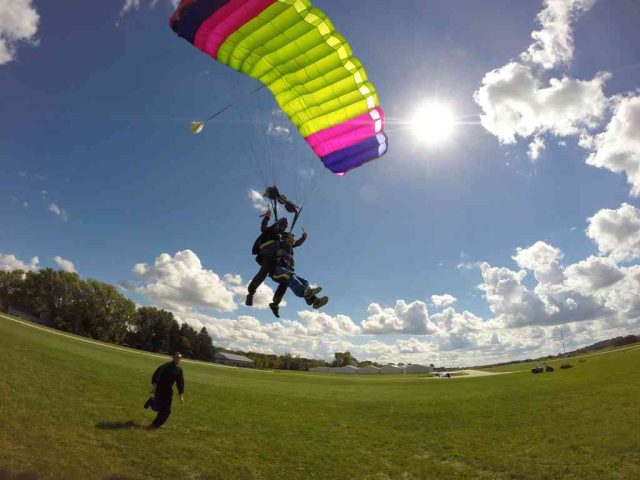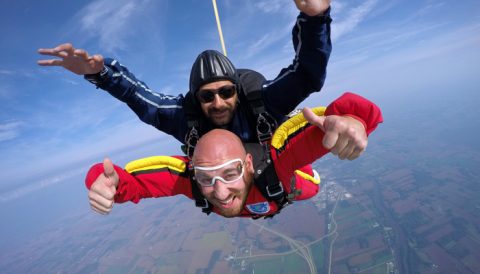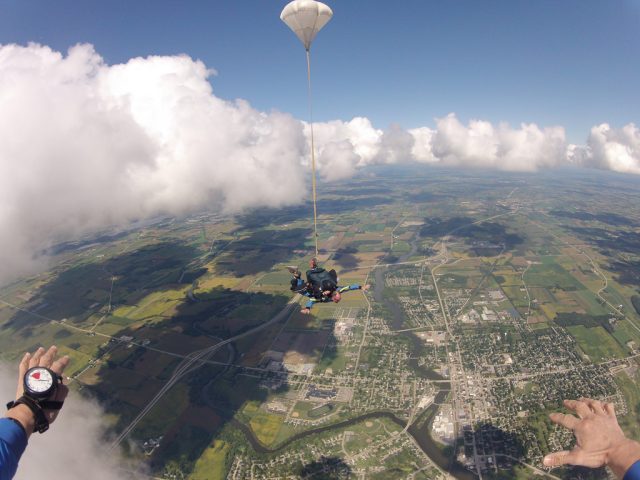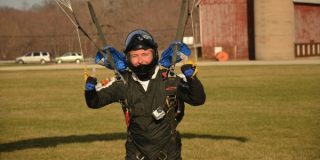SKYDIVING TERMINOLOGY EXPLAINED
Skydiving Tips
Posted by: Wisconsin Skydiving Center 8 years ago
Skydiving: like any sport, has its own language. So, if all the skydiving terms you’re hearing is leaving you a little confused, don’t despair: We’re here with a quick glossary of common phrases to help you navigate life on the dropzone.
AAD

AAD stands for “Automatic Activation Device.” This is the little piece of equipment that will deploy your reserve parachute on your behalf just in case you aren’t able to do it yourself–you went unconscious, for instance, or you have another problem that prevents you from doing it yourself. AADs have saved lots of lives since they were invented–and they’re one of the big reasons that skydiving fatalities are so extremely uncommon in the modern era. We love our AADs!
BOOGIE
Skydivers are big on tradition and big on fun, and both elements are represented in fine form at a boogie. A “boogie,” after all, is a skydiving party! We started using the term in the 1960s, when the sport was in its infancy, using what was then a common word for a wild shindig, and we’ve never stopped. These days, almost every dropzone in the world has its own boogie schedule–from one per year to one per month. At many dropzones, these parties have been an annual tradition for decades.
CANOPY

We don’t often use the word “parachute” to describe our parachutes. Weird, huh? Well: it’s true. We like to call our parachutes “canopies” or, less commonly, “wings.”
CRW
Another fun acronym, pronounced “crew,” is CRW–Canopy Relative Work. Y’know those photos you see of a whole bunch of skydiving canopies arranged in an orderly stack, like a line or a box or a diamond? Well: those are jumpers we like to refer to as “CReW dogs,” doing their (amazing) thing. Want to see them in action? Check out this video of 80 skydivers forming a diamond shape while under canopy.
FORMATION SKYDIVING
You can do a formation skydive as a group of two or a group of four hundred (though the 400-way is pretty darn challenging). How? Well: you get out of the plane in a suit that has flat pillow handles sewn to the limbs. Then you point your belly button at the ground and you set about gripping on to the handles of the skydivers around you in a very precise, particular sequence. Watch amazing footage of 108 men and women creating two formations in one jump.
FREEFALL

Freefall is the “falling” part of the skydive. It’s what you’re in after you get out of the plane and before you open up your canopy.
PILOT CHUTE

Your big canopy needs a little parachute in order to get out of the container that it’s folded up in. That little parachute is called a “pilot chute.” The pilot chute is much smaller than the main canopy. It’s attached to a handle at the top and to a long bridle at the bottom. The bridle is attached to the pins that hold the container closed. When the skydiver wants to deploy her main canopy, she grabs the handle and throws the pilot chute out into the airflow. When it inflates, it tugs the bridle after it, which tugs the pins out. Once the container is open, the main canopy is free to get out of the container and do its thing.
RIGGER
Riggers are the mechanics of the skydiving industry. They repack our reserves on the FAA’s hallowed schedule; they patch our canopies; they resize our harnesses; they tinker with our wingsuits; they embroider inflammatory patches on our jumpsuits. They take care of our nylon toys so our nylon toys can take care of us, and we love ’em for it.
TOGGLES

The toggles are the loops we pull on to control our canopy flight. They’re stiffened fabric hooks that attach via Velcro to the risers of our canopies. As you can see in the image below, the experienced skydiver utilized his toggles for a controlled landing.
USPA
The USPA, or United States Parachute Association, is the governing body that has, in some way or another, been overseeing the sport of skydiving since the very infancy of the activity. It’s gone from–well–no members to a worldwide membership of hundreds of thousands, and it has been instrumental in the advances in procedure, training, technology and maintenance that have made skydiving as safe and popular as it is today. We salute you, USPA!
WHUFFO
“Whuffo” is a slightly arcane term for someone who doesn’t skydive. It supposedly came from the sentence, “You jump out of planes? What for?” That’s a confusing connection, I know–but if you moosh and garble that “what for,” you get “whuffo.” It’s not very much in use these days, because let’s face it–everyone knows why you jump out of a plane: It’s awesome.
Wanna see just how awesome? You know you don’t wanna be a whuffo no mo. Make your first skydive at Wisconsin Skydiving Center today!
Categories:
You May Be Interested In:

Can You Skydive With Dentures?
2 months ago by Wisconsin Skydiving Center

Why Is Skydiving So Expensive?
4 months ago by Wisconsin Skydiving Center

Can You Skydive In The Winter?
5 months ago by Wisconsin Skydiving Center

23 of the Best Skydiving Quotes and Captions for Social Media
1 year ago by Wisconsin Skydiving Center